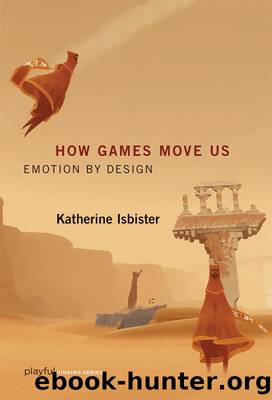How Games Move Us: Emotion by Design (Playful Thinking) by Katherine Isbister

Author:Katherine Isbister
Language: eng
Format: mobi
ISBN: 9780262034265
Publisher: MIT Press
Published: 2016-03-04T06:00:00+00:00
Notes
1. Entertainment Software Association, âEssential Facts about the Computer and Video Game Industry,â 2015, http://www.theesa.com/wp-content/uploads/2015/04/ESA-Essential-Facts-2015.pdf (accessed August 26, 2015).
2. Johan Huizenga, Homo Ludens: A Study of the Play Element in Culture (Boston, MA: Beacon Press, 1955).
3. Hara Estroff Morano, âThe Dangers of Loneliness,â Psychology Today, July 1, 2003, https://www.psychologytoday.com/articles/200308/the-dangers-loneliness (accessed August 26 2015).
4. Regan L. Mandryk and Kori M. Inkpen, âPhysiological Indicators for the Evaluation of Co-Located Collaborative Play,â CSCW â04 Proceedings of the 2004 ACM Conference on Computer-Supported Cooperative Work, Chicago, IL (2004): 102, doi:10.1145/1031607.1031625.
5. Anna Macaranas, Gina Venolia, Kori Inkpen, and John Tang, âSharing Experiences over Video: Watching Video Programs Together at a Distance,â HumanâComputer InteractionâINTERACT 2013, Cape Town, South Africa (2013): 73â90.
6. Jaako Stenros, Janne Paavilainen, and Frans Mäyrä, âThe Many Faces of Sociability and Social Play in Games,â Proceedings of the 13th International MindTrek Conference, Tampere, Finland (2009): 82â89.
7. Kerry L. Marsh, Michael J. Richardson, and R. C. Schmidt, âSocial Connection through Joint Action and Interpersonal Coordination,â Topics in Cognitive Science 1, no. 2 (2009): 320, doi:10.1111/j.1756-8765.2009.01022.x; Pierecarlo Valdesolo and David DeSteno, âSynchrony and the Social Tuning of Compassion,â Emotion 11, no. 2 (2011): 262, doi: 10.1037/a0021302; Pierecarlo Valdesolo, Jennifer Ouyang, and David DeSteno, âThe Rhythm of Joint Cction: Synchrony Promotes Cooperative Ability,â Journal of Experimental Social Psychology 46, no. 4 (2010): 693, doi:10.1016/j.jesp.2010.03.004.
8. GameOn @ IGS Corporation Limited, How to Control Sackboy: LBP2 Acting, YouTube video, 1:50, October 21, 2011, https://www.youtube.com/watch?v=LHF7Psvu6GM (accessed August 26, 2015).
9. Brendan Keogh, âA Sackboy Says No Words,â Kill Screen, March 15, 2011, http://killscreendaily.com/articles/sackboy-says-no-words/ (accessed August 26, 2015).
10. Ibid.
11. calculatorboyqwe, New LittleBigPlanet Sackzilla Trailer HD Quality, YouTube video, 1:48, September 3, 2008, https://www.youtube.com/watch?v=xdvSAkgN-FU&feature=player_embedded (accessed August 26, 2015).
12. Erving Goffman, The Presentation of Self in Everyday Life (New York: Anchor Books, 1959).
13. D. Fox Harrell, Phantasmal Media: An Approach to Imagination, Computation, and Expression (Cambridge, MA: MIT Press, 2013).
14. Michael S. Rosenberg, âVirtual Reality: Reflections of Life, Dreams, and Technology: An Ethnography of a Computer Society,â unpublished manuscript, 1992, https://w2.eff.org/Net_culture/MOO_MUD_IRC/rosenberg_vr_reflections.paper (accessed March 26, 2015).
15. Quoted in Sherry Turkle, Life on the Screen: Identity in the Age of the Internet (New York: Simon & Schuster, 1995).
16. Ibid.
17. âRip City of Heroes,â Penny Arcade, August 2012, http://forums.penny-arcade.com/discussion/166289/rip-city-of-heroes (accessed January 31, 2015).
18. Ibid.
19. Ibid.
20. Ibid.
21. Ibid.
22. Ibid.
23. Ibid.
24. Walter Mischel, âToward an Integrative Science of the Person,â Annual Review of Psychology 55 (2004): 1â22.
25. Mary Flanagan, Daniel C. Howe, and Helen Nissenbaum, âValues at Play: Design Tradeoffs in Socially-Oriented Game Design,â CHI â05 Proceedings of the SIGCHI Conference on Human Factors in Computing Systems, Portland, OR (2005): 751, doi:10.1145/1054972.1055076; Bernie DeKoven, The Well-Played Game: A Playful Path to Wholeness (Lincoln, NE: iUniverse, Inc., 2002).
26. âkeep me occupied,â Auntie Pixelante, January 9, 2012, http://www.auntiepixelante.com/?p=1461 (accessed August 26, 2015).
27. Espen Aarseth, âI Fought the Law: Transgressive Play and the Implied Player,â Proceedings of DiGRA 2007 Conference: Situated Play, Tokyo, Japan (2007): 130, http://www.digra.org/wp-content/uploads/digital-library/07313.03489.pdf (accessed August 26, 2015); Mia Consalvo, Cheating: Gaining Advantage in Videogames (Cambridge, MA: MIT Press, 2009).
28. Raph Koster, âThe Laws of Online World Design,â Raph Kosterâs Website, http://www.
Download
This site does not store any files on its server. We only index and link to content provided by other sites. Please contact the content providers to delete copyright contents if any and email us, we'll remove relevant links or contents immediately.
Unwinding Anxiety by Judson Brewer(70159)
The Art of Coaching by Elena Aguilar(50007)
The Fast Metabolism Diet Cookbook by Haylie Pomroy(20486)
Rewire Your Anxious Brain by Catherine M. Pittman(17585)
Healthy Aging For Dummies by Brent Agin & Sharon Perkins RN(16608)
Talking to Strangers by Malcolm Gladwell(11874)
The Art of Thinking Clearly by Rolf Dobelli(8839)
Crazy Rich Asians by Kevin Kwan(8347)
Mindhunter: Inside the FBI's Elite Serial Crime Unit by John E. Douglas & Mark Olshaker(7833)
The Compound Effect by Darren Hardy(7553)
Crystal Healing for Women by Mariah K. Lyons(7374)
Therapeutic Modalities for Musculoskeletal Injuries, 4E by Craig R. Denegar & Ethan Saliba & Susan Saliba(7348)
Periodization Training for Sports by Tudor Bompa(7327)
Bodyweight Strength Training by Jay Cardiello(7183)
Becoming Supernatural by Dr. Joe Dispenza(7102)
Wonder by R. J. Palacio(7055)
Tools of Titans by Timothy Ferriss(6944)
Should I Stay or Should I Go? by Ramani Durvasula(6784)
How to Be a Bawse: A Guide to Conquering Life by Lilly Singh(6692)
